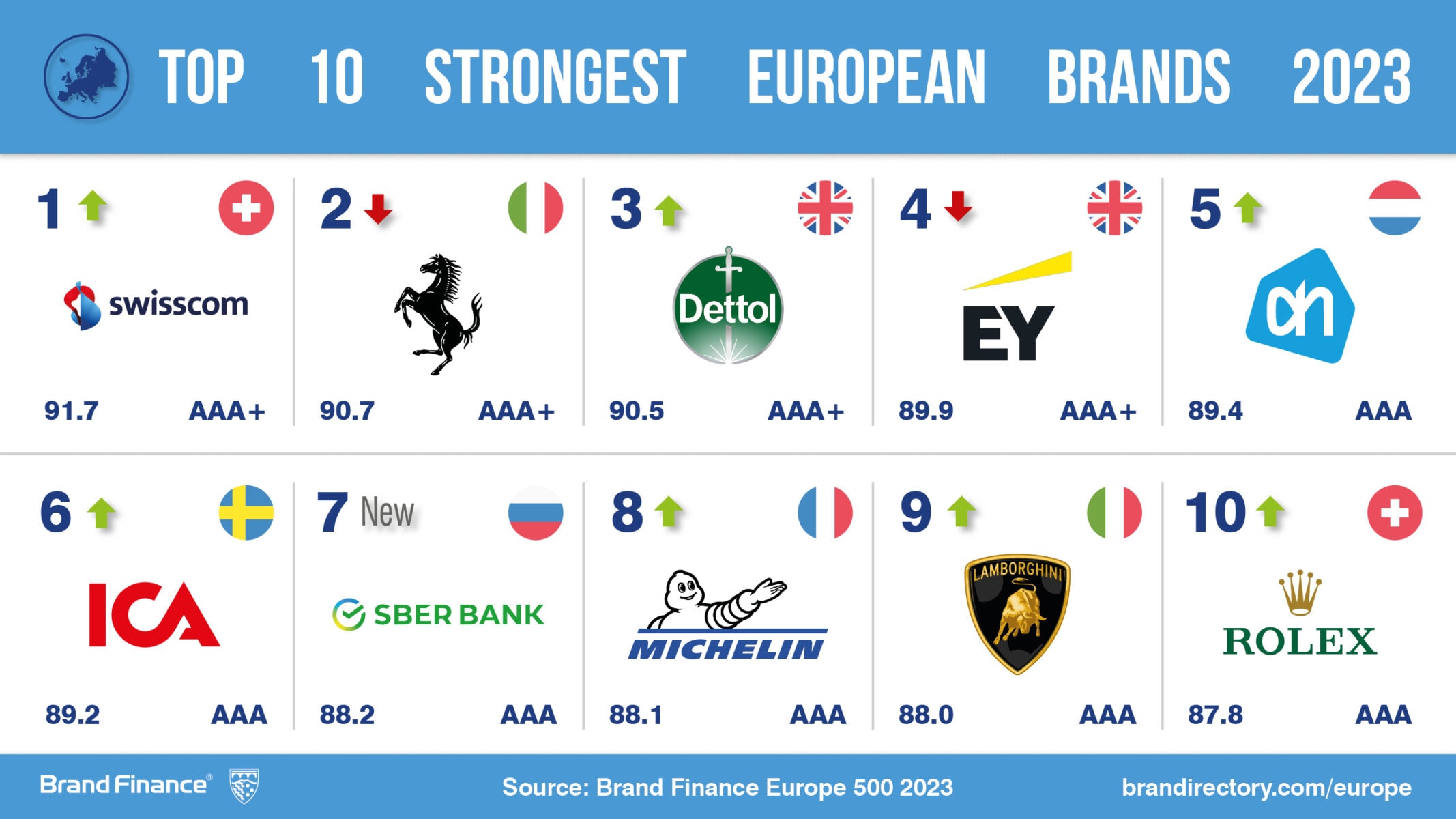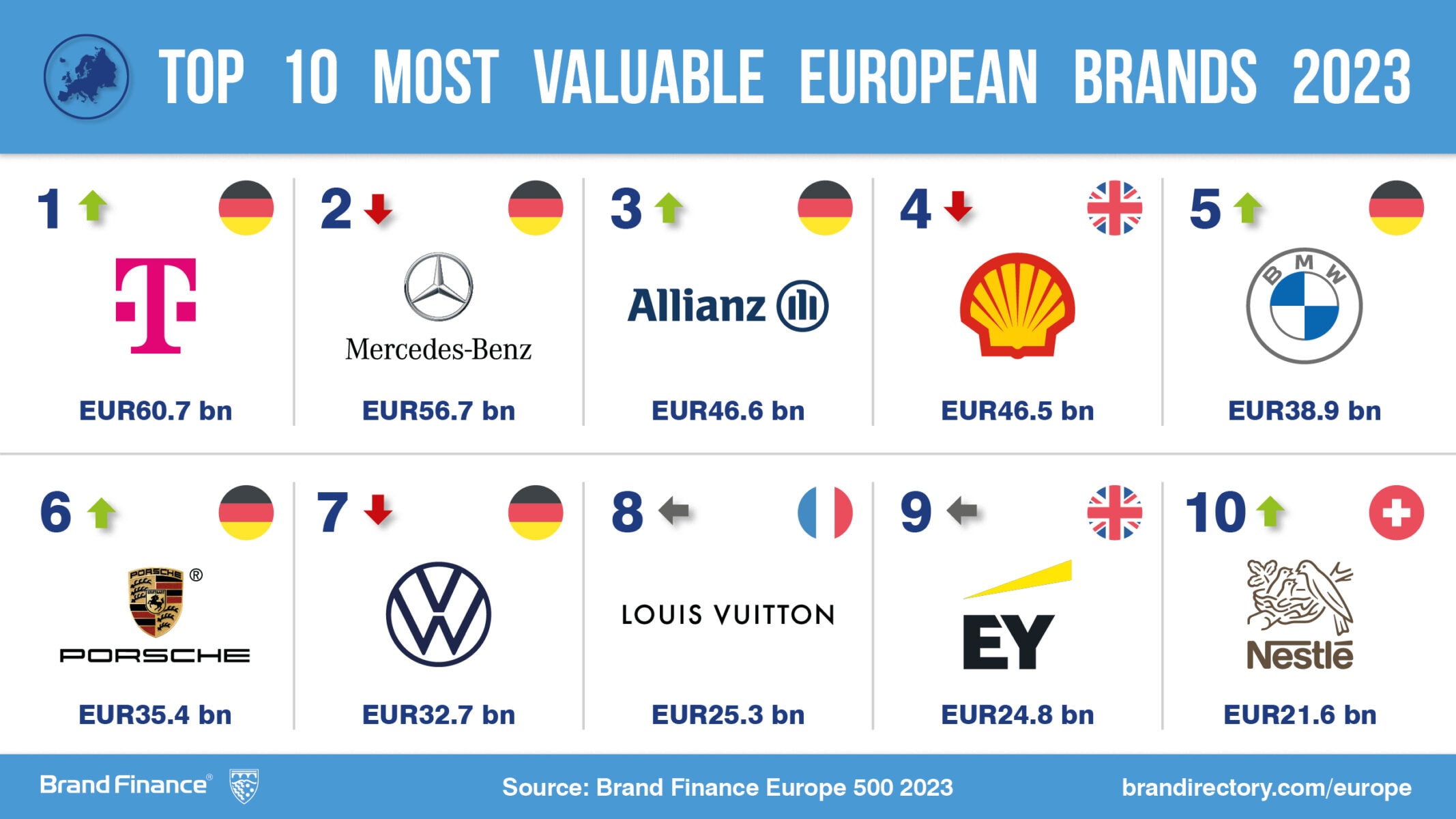View the full Brand Finance Europe 500 2023 report here
Swedish global home furnishing brand IKEA (brand value up 2% to EUR15.4 billion) has achieved an uplift in revenues despite relatively flat volumes as it implemented price hikes to offset inflation and supply chain issues. Nonetheless, 2023 saw IKEA expand its retail operations, becoming available in markets including Estonia, Oman, Philippines, Puerto Rico, and South America. In addition to global expansion, IKEA has also continued to take steps towards opening more city-centre stores in a bid to improve in-store visits and encourage consumer loyalty.
Every year, leading brand valuation consultancy Brand Finance puts 5,000 of the biggest brands to the test, and publishes over 100 reports, ranking brands across all sectors and countries. The world’s top 500 most valuable and strongest European brands are included in the annual Brand Finance Europe 500 2023 ranking.
Anna Brolin, Managing Director of Brand Finance Nordics, commented:
“IKEA has sought to support its position in what continues to be a challenging business environment by implementing price hikes, but the negative impact on consumer perceptions does present some difficulties for the brand. IKEA now needs to address consumers’ concerns by improving brand communication to regain trust and equity, and prove it remains the leading affordable home furnishings and solutions provider, not just in Sweden, but across the whole European market.”
ICA (brand value up 37% to EUR1.7 billion) is the 6th strongest European brand, with an impressive BSI (Brand Strength Index) score of 89/100 and an AAA rating. A high brand loyalty score and positive consumer perceptions relating to ICA’s quality, range of products and usage, has propelled the brand’s strength. The brand has also increased its brand strength through its sustainability initiatives, having recently won the United Nations climate award, and supporting consumers with a wide range of ethically sourced and labelled products.

AkerBP’s (brand value up 130% to EUR2.7 billion) impressive brand value increase saw it climb an immense 186 places in this year’s ranking. This increase can be attributed to the brand’s acquisition of Lundin Energy’s exploration and production business and resulting improved market share. In turn, AkerBP’s improved financial performance due to increased revenues have contributed to this impressive brand value growth. Looking ahead, AkerBP can expect significant increases in production as it plans to invest approximately EUR13 billion in development projects.
Denmark’s MAERSK (brand value up 71% to EUR7.1 billion) has achieved record revenues this past year, with forecasts increasing in a similar manner. Maersk has expanded its air cargo business, now offering direct flights between Korea, China, and the US. These services will connect manufacturing and commercial hubs in eastern China with those in the US East Coast and Mid-West, amongst other key routes. It has also acquired LF Logistics, the brand’s most consequential acquisition to date, further enhancing its footprint in Asia.
As Finland’s biggest exporter of food products, Valio (brand value up 13% to EUR1.4 billion) has sustainability at the forefront of its communication with stakeholders. Owned by 4,000 dairy farms through cooperatives that supply raw milk to Valio, the brand has worked towards supplying more sustainable food options, while also supporting the communities and areas that it works in. This has built a strong sustainability perception amongst stakeholders and contributed to its positive performance in this metric in the ranking.
Of the 121 countries included in Brand Finance’s Global Soft Power Index 2023, Sweden (11th) climbed three places since last year’s ranking, Norway (17th) and Denmark (18th) each maintained their rankings, and Finland (22nd) and Iceland (34th) also climbed three ranks.
Despite their relatively small economies on the global stage, Nordic countries performed strongly in terms of perceived “Business & Trade”. In addition, all Nordic countries ranked in the top fifteen for “Sustainable Future”: Sweden 3rd, Norway 5th, Denmark 9th, Finland 10th, and Iceland 15th, indicative of Nordic countries’ leading position in sustainable development. These two elements are viewed favourably by the world as important factors for shaping the future of nation branding.
German telecoms provider Deutsche Telekom (brand value up 17% to EUR60.7 billion) has surpassed former champion Mercedes-Benz (brand value up 8% to EUR€56.7 billion) to become the most valuable European brand. Building on its success as the second most valuable telecoms brand globally, Deutsche Telekom’s latest title as the most valuable European brand comes as a result of strong revenue growth across European markets and increasing customer numbers. The latter has also significantly propelled the brand’s growth in the US, which has seen record customer additions.

Brand Finance is the world’s leading brand valuation consultancy. Bridging the gap between marketing and finance, Brand Finance evaluates the strength of brands and quantifies their financial value to help organisations make strategic decisions.
Headquartered in London, Brand Finance operates in over 25 countries. Every year, Brand Finance conducts more than 6,000 brand valuations, supported by original market research, and publishes over 100 reports which rank brands across all sectors and countries.
Brand Finance also operates the Global Brand Equity Monitor, conducting original market research annually on 6,000 brands, surveying more than 175,000 respondents across 41 countries and 31 industry sectors. By combining perceptual data from the Global Brand Equity Monitor with data from its valuation database — the largest brand value database in the world — Brand Finance equips ambitious brand leaders with the data, analytics, and the strategic guidance they need to enhance brand and business value.
In addition to calculating brand value, Brand Finance also determines the relative strength of brands through a balanced scorecard of metrics evaluating marketing investment, stakeholder equity, and business performance, compliant with ISO 20671.
Brand Finance is a regulated accountancy firm and a committed leader in the standardisation of the brand valuation industry. Brand Finance was the first to be certified by independent auditors as compliant with both ISO 10668 and ISO 20671 and has received the official endorsement of the Marketing Accountability Standards Board (MASB) in the United States.
Brand is defined as a marketing-related intangible asset including, but not limited to, names, terms, signs, symbols, logos, and designs, intended to identify goods, services, or entities, creating distinctive images and associations in the minds of stakeholders, thereby generating economic benefits.
Brand strength is the efficacy of a brand’s performance on intangible measures relative to its competitors. Brand Finance evaluates brand strength in a process compliant with ISO 20671, looking at Marketing Investment, Stakeholder Equity, and the impact of those on Business Performance. The data used is derived from Brand Finance’s proprietary market research programme and from publicly available sources.
Each brand is assigned a Brand Strength Index (BSI) score out of 100, which feeds into the brand value calculation. Based on the score, each brand is assigned a corresponding Brand Rating up to AAA+ in a format similar to a credit rating.
Brand Finance calculates the values of brands in its rankings using the Royalty Relief approach – a brand valuation method compliant with the industry standards set in ISO 10668. It involves estimating the likely future revenues that are attributable to a brand by calculating a royalty rate that would be charged for its use, to arrive at a ‘brand value’ understood as a net economic benefit that a brand owner would achieve by licensing the brand in the open market.
The steps in this process are as follows:
1 Calculate brand strength using a balanced scorecard of metrics assessing Marketing Investment, Stakeholder Equity, and Business Performance. Brand strength is expressed as a Brand Strength Index (BSI) score on a scale of 0 to 100.
2 Determine royalty range for each industry, reflecting the importance of brand to purchasing decisions. In luxury, the maximum percentage is high, while in extractive industry, where goods are often commoditised, it is lower. This is done by reviewing comparable licensing agreements sourced from Brand Finance’s extensive database.
3 Calculate royalty rate. The BSI score is applied to the royalty range to arrive at a royalty rate. For example, if the royalty range in a sector is 0-5% and a brand has a BSI score of 80 out of 100, then an appropriate royalty rate for the use of this brand in the given sector will be 4%.
4 Determine brand-specific revenues by estimating a proportion of parent company revenues attributable to a brand.
5 Determine forecast revenues using a function of historic revenues, equity analyst forecasts, and economic growth rates.
6 Apply the royalty rate to the forecast revenues to derive brand revenues.
7 Discount post-tax brand revenues to a net present value which equals the brand value.
Brand Finance has produced this study with an independent and unbiased analysis. The values derived and opinions presented in this study are based on publicly available information and certain assumptions that Brand Finance used where such data was deficient or unclear. Brand Finance accepts no responsibility and will not be liable in the event that the publicly available information relied upon is subsequently found to be inaccurate. The opinions and financial analysis expressed in the study are not to be construed as providing investment or business advice. Brand Finance does not intend the study to be relied upon for any reason and excludes all liability to any body, government, or organisation.
The data presented in this study form part of Brand Finance's proprietary database, are provided for the benefit of the media, and are not to be used in part or in full for any commercial or technical purpose without written permission from Brand Finance.